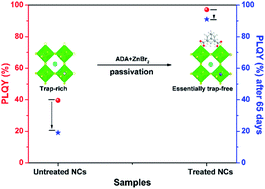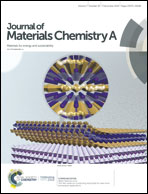Ultra-stable CsPbBr3 nanocrystals with near-unity photoluminescence quantum yield via postsynthetic surface engineering†
Abstract
Lead halide perovskite nanocrystals (NCs) have recently attracted intense interest as promising luminophores for optoelectronic devices. However, their extensive applications are still hampered by a high-cost synthesis method and the poor stability and low photoluminescence quantum yield (PLQY) of NCs. To address these issues, herein, a fast, room-temperature method is adopted to prepare CsPbBr3 NCs with the use of green synthetic solvents. More importantly, we explore an efficient postsynthetic dual-surface-passivation strategy of CsPbBr3 NCs with 1,3-adamantanedicarboxylic acid (ADA) and ZnBr2 ligands, which exhibits near-unity PLQY and ultra-high stability. The theoretical results show that such a remarkable performance stems from efficient passivation of the massive surface defects of CsPbBr3 with ADA and ZnBr2, suppressing the formation of surface nonradiative recombination centers. Besides, we fabricated white light-emitting diodes (WLEDs) based on essentially trap-free CsPbBr3 NCs. The optimal device exhibits a luminous efficiency of up to 68.7 lm W−1 and wide color gamut of 119% of the NTSC standard.



 Please wait while we load your content...
Please wait while we load your content...